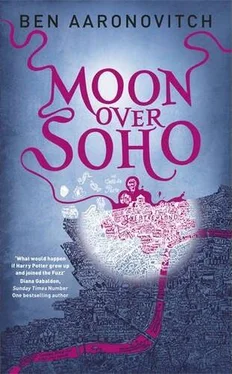Carlisle House became London’s first members-only club. For a modest subscription one could enjoy an evening of opera, good food, and, it was rumored, convivial intimate company. It was Teresa who established the time-honored Soho tradition of packing them in, getting them drunk, and fleecing them till they squeaked. Alas, she was a better hostess than bookkeeper and eventually, after two decades, several bankruptcies, and a comeback tour she died alone and penniless in a debtors’ prison.
The rise and fall of Teresa Cornelys proves three things: that the wages of sin are high, that you should “just say no” to opera, and that it’s always wise to diversify your investment portfolio. This was the advice followed by Gabriella Rossi, also Italian, who arrived in London as a child refugee in 1948. After a career in the rag trade she opened her first branch of A Glimpse of Stocking in 1986 where she profited from the wages of sin, albeit tastefully, said no to opera, and made sure that her portfolio was suitably robust. When she died in 2003 it was as Dame Rossi, knighted for her services to naughtiness and leaving behind a small chain of lingerie shops.
The Soho branch was managed by a skinny blond woman who dressed in a no-nonsense trouser suit, but with no blouse, and worryingly thin wrists. She seemed genuinely amused when I showed her my warrant card and although she had no recollection of Henry Bellrush, she laughed out loud when I suggested that he might have been buying for himself.
“I doubt that,” she said. “This particular type of corset has a ‘vintage’ waist. It’s designed to be ten inches smaller than the hips — I doubt a man could wear that.”
The shop was artfully cluttered with antique display racks and cabinets to give it a pleasantly retro feel so that even the English could enjoy frilly underwear safe in the knowledge that it came wrapped up with an ironic postmodern bow. On one wall there were framed photographs of women, all either monochrome or in the faded tones of 1960s color photography. The women were mostly half naked or dressed in corsets and the kind of frilly knickers that probably got my father in a twist. One was the famous Morley portrait of Christine Keeler sitting backward on a rather uncomfortable-looking Scandinavian chair. Several had been autographed and I recognized one of the names — Rusty Gaynor, the legendary queen of Soho strippers in the 1960s.
The manageress checked carefully through the receipts.
“Definitely not a man,” she said. “Not in these sizes. Although judging from the rest of the items, we’re talking about a big healthy girl here. If I had to make a guess I would say these were bought for a stage act.”
“What kind of act?”
“A burlesque dancer,” she said. “Without a doubt. Probably one of Alex’s girls. Alexander Smith, puts on shows down at the Purple Pussycat. Very tasteful.”
“A stripper you mean?” I asked.
“Oh dear,” said the manageress. “You mustn’t call them that.”
THE DIFFERENCE between stripping and burlesque, as far as I could tell, was class.
“We don’t have poles onstage,” said Alexander Smith, burlesque impresario. He was a thin fox-faced man in a fawn-colored suit with 1970s lapels but not, because there are limits to decency, a kipper tie. Instead he wore a plum-colored ascot with matching pocket handkerchief and, probably, silk socks. He was so completely camp that it didn’t really come as too much of a surprise that he was married with grandkids. No gay man would have to work that hard. Smith cheerfully showed me the photographs of “her indoors” — his wife — along with little Penelope and Esmerelda, and explained why poles were the work of the devil.
“Inventions of Beelzebub himself,” he said. “Stripping is about getting your kit off in time to the music. There’s no real eroticism to it, the punters want to see her minge and she wants to get paid. Wham bam, no thank you, ma’am.”
Over his shoulder I watched as a fit-looking white woman on the club’s small stage rotated her hips to Lounge Against the Machine’s cover of “Baby’s Got Back.” She was wearing a dancer’s leotard and a baggy pink sweat top and I had to admit that, despite the lack of minge, I was suitably entranced. Smith turned to see what I was watching.
“It’s about glamour,” he said. “And the art of sensuality. The sort of show you could bring your mother to.”
Not my mother, I thought. She doesn’t do ironic postmodernism.
I showed Smith the picture of Henry Bellrush I’d gotten from his wife. “That’s Henry,” said Smith. “Has something happened to him?”
“Was he a regular?” I asked to move us on.
“He’s an artiste,” said Smith. “A musician. Beautiful, beautiful cornet player. He does this act with this lovely girl called Peggy. Very classy, just him on the cornet and her moving as he played. She could hold an audience transfixed just by taking her glove off. They used to sigh when she went topless ’cause they knew it was almost over.”
“And their relationship was strictly business?” I asked.
“You keep using the past tense,” said Smith. “Something has happened, hasn’t it?”
I explained that Henry Bellrush was dead and that I was conducting routine inquiries.
“Well, that’s a shame,” said Smith. “I wondered why they hadn’t turned up for a while. In answer to your question, those two were strictly professional, he liked playing and she liked dancing. I think that’s as far as it went.”
He also liked buying her the costumes, or perhaps he saw it as an investment. I wondered whether I should tell his wife or not.
I asked if he had any publicity pictures of the mysterious Peggy but, although he was sure they existed, he didn’t have any at the club.
I asked when their last gig was and he gave a date back at the start of the month, less than a day before Bellrush died. “Was it here?” I asked. Fourteen days was a long time for transient vestigia to be retained, but it was worth a try.
“No,” said Smith. “Much more classy than this — it was part of our Summer Burlesque Festival at the Café de Paris. We hold one every year to raise awareness of burlesque among the public.”
I EMERGED blinking into weak afternoon sunlight and before I could get my bearings I was ambushed by Simone Fitzwilliam.
“Constable,” she said brightly, and slipped her arm through mine. “What brings you to my neighborhood again?” Her arm was warm and soft against my side, and I smelled honeysuckle and caramel.
I told her I was still investigating some suspicious deaths.
“Including poor Cyrus?” she asked.
“I’m afraid so.”
“Well, I’m determined to put that behind me,” she said. “Cyrus wouldn’t have wanted me to mope. He believed in living in the moment and double-entry bookkeeping. But then if we were all the same, where would be the fun in that? So where next will our sleuthing take us?”
“I need to check out the Café de Paris,” I said.
“Oh,” she said. “I haven’t been there for such a long time. You must take me, I could be your plucky sidekick.”
How could I argue with that.
I lied my way into the Café de Paris by claiming I was following up a spot check by Clubs and Vice and that I could be in and out in five minutes. The day manager either bought it or wasn’t being paid enough money to care either way.
The interior was a riot of gold leaf, red velvet, and royal blue drapes. The main room was oval with a split staircase at one end and small stage at the other. A balcony swept around the circumference that reminded me uneasily of the Royal Opera House.
“You can just feel the history,” said Simone, clutching my arm. “The Prince of Wales used to come here regularly.”
Читать дальше












